From The CRPG Addict
Total Hours: 4
Difficulty: Moderate (3/5)
Final Rating: (to come later)
Ranking at time of posting: (to come later)
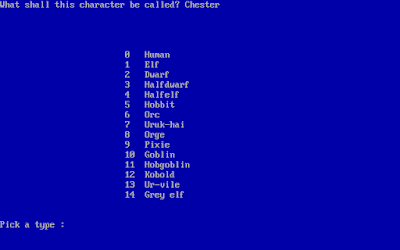 |
| A mix of D&D, Tolkien, and Donaldson in the race list was an early clue. |
Like Wizardry, Nemesis isn’t an exact copy, and has plenty of its own innovations, so we shouldn’t go too far in making accusations of plagiarism and such. In fact, in making their adaptation, the authors–Michael A. Pagels and Michael Q. Hiller–changed enough of the elements (in particular getting rid of the 3-D interface) that I might not have noticed the association. What tipped me off was the use of “ur-vile” (from Stephen Donaldson’s Thomas Covenant series) as a character class. I knew I’d seen that before, searched my blog, and came up with my entry on Oubliette. From there, I noticed that the list of races for the two games were exactly the same, in the same order, excepting the replacement of “Eldar Elf” with “Grey Elf.” Then I got hold of the game manual and noted that the address for SuperSoft was a post office box in Champaign.
Getting the game running was no picnic. The only reliable CP/M emulator that I could find (Simeon Cran’s MicroFast) was for DOS, which put me in the weird position of running an emulator within an emulator. The game then requires you to create a configuration file for the terminal you’re using before you can run it. It has configurations programmed for numerous terminals, but none of them seemed to overlap with the various options offered by MicroFast. Actually, one did–the D.E.C. VT-52–but I overlooked it for a while, wasted a lot of time trying to define my own terminal type, and nearly gave up before I figured it out.
Nemesis is necessarily dumbed-down from Oubliette. Microcomputers of 1981 had nothing like the resources of the PLATO mainframe. Oubliette‘s explorable “town” level with numerous shops, inns, and so forth was (like in Wizardry) turned into a menu town. Instead of a party, a single character adventures alone. Combat is rendered considerably easier as a consequence.
But the basic rules, logistics, and statistics come directly from Oubliette, which itself drew heavily from Dungeons & Dragons and a few other sources. Character creation has you choose first from 15 races: human, elf, dwarf, half-dwarf, half-elf, hobbit, orc, uruk-hai, ogre (misspelled “orge”), pixie, goblin, hobgoblin, kobold, ur-vile, and grey elf. The game then randomly rolls for your strength, intelligence, wisdom, charisma, constitution, dexterity, gold, and (weirdly enough) sex. The rolls are modified by your race choice. You also choose an alignment from lawful, neutral, or chaotic, which was also used by Oubliette but goes back to original D&D.
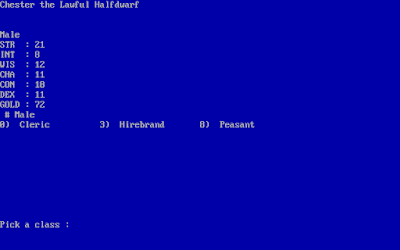 |
| Choosing a class after rolling attributes. |
You can re-roll as many times as you want before accepting the character, at which point you choose from a list of available classes, with those that don’t meet your minimum attributes filtered out. There are 15 classes, and they again match Oubliette’s list in names and order, except for the substitution of “rogue” for thief and “featheror” for courtesan. Nemesis‘s full list is cleric, demondim, featheror, hirebrand, mage, minstrel, ninja, paladin, raver, peasant, ranger, rogue, sage, samurai, and valkyrie. After a few false starts with boilerplate characters (e.g., an ogre hirebrand), I decided to aim for a “minstrel” because it amused me to think of an adventurer pratfalling his way through a dungeon while belting a tune about his mammy down in Alabamy.
The menu town has an armory for buying and selling weapons and armor, a hospital, an inn, and Archives. Hospitals and inns both let you restore hit points. Hospitals cost money but heal you a lot faster (in game days) than inns, which has implications for your longevity. The Archives is where you go to pay money to have unknown items identified. New characters have no equipment, but they also have so little gold that you usually can’t buy anything. Even a “pointed stick” costs over 100 gold pieces. So you enter the dungeon and take a chance with your hands.
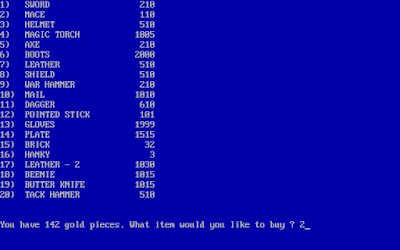 |
| Visiting the store. I have no idea why I’d need a hanky, brick, or beenie. |
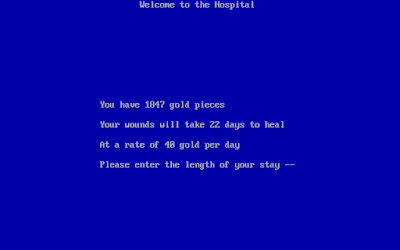 |
| Visiting the hospital after a rough dungeon trip. |
Gameplay consists mostly of wandering the 21 x 23 dungeon levels, picking up equipment as you find it, and killing monsters as they attack you. The items you find almost immediately outclass what’s available in the store, so you mostly use gold for healing and identifying items in the archives. You want to stay near the entrance until you gain a few levels and extra hit points; although combat is relatively easy on Level 1, the game still features permadeath, and you can always get unlucky.
The dungeon is rendered in roguelike fashion, with ASCII characters representing the walls and doors, rather than in the 3D graphical fashion of Oubliette. It’s possible that the developers were exposed to Rogue but equally possible that they came up with the idea independently. In addition to stairs, players can encounter chutes and pits to lower levels, teleporters, anti-magic rooms, anti-cleric rooms, “melee rooms” (every square has a combat), and special treasure rooms. You maneuver with the URLD keys.
 |
| Making my way through the dungeon. The character is a flashing underscore, so don’t ask me to find it on this static shot. |
Combat is drawn largely unchanged from Oubliette. When you encounter an enemy party, you’re taken to a separate screen. Where you can see your own statistics and inventory and the enemy groups that you face. Your options are only (F)ight, (C)leric spell, (M)age spell, and (U)se a special item. There is no fleeing or parrying. Even worse, the point of most of the character classes is nullified, as the authors failed to adapt any of their special abilities. Courtesans/”featherors” and minstrels can no longer charm enemies; rogues and ninjas can’t hide; clerics cannot dispel undead; paladins cannot lay on hands. There is a suggestion that some of these abilities were intended for a sequel.
 |
| I believe the primary party I’m fighting is orcs, but I caught this in the process of refreshing the screen. Two mediums (priestly classes) have joined the battle. |
Other monsters may appear to join a battle in progress. As you kill them, you see your experience and gold increase. Leveling happens when you leave the dungeon, and it’s accompanied by increases in maximum health and spell points.
Nemesis offers 55 different monster types, and all of them appear in Oubliette with a few exceptions, and those exceptions are all simple substitutions. For instance, Oubliette‘s giant spider and giant ant become “huge spider” and “large ant” in Nemesis. Oubliette has a lot more monsters than Nemesis; those that didn’t make the cut tend to be the higher-level monsters like dragons, medusas, and advanced spellcasters, and I suspect that the Nemesis authors didn’t know how, or didn’t have the space, to program those enemies’ special attacks.
 |
| The game’s town. Oubliette had stores, hospitals, and inns, but I think the Archives are original to this game. |
There is some overlap in the games’ spells, but on the other hand, the 13 mage spells and 11 cleric spells offered by Nemesis are common enough that they could have come from anywhere. Nemesis doesn’t require you to know a spell code name to cast its spells. They are separated into travel spells (“Light,” “Protect,” “Levitate”) and combat spells (“Damage,” “Sleep,” “Fireball”), and each depletes a number of magic points from the character’s pool.
There’s no main quest or winning condition in Nemesis. The manual encourages you to set your own goals, such as a certain experience level or treasure level. Survival isn’t very hard if you can live past Level 0 and if you play conservatively, for instance returning to the surface when you’ve lost half your health. The game earns only a 12 in my GIMLET, with no element rising above a 2. It is particularly hurt by the lack of any backstory, NPCs, or quests (all 0).
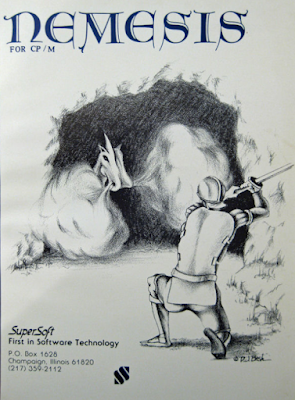 |
| Ironically, one of the monster types that the game did not adapt from Oubliette was dragons. |
The manual indicates that Nemesis II was already under development when Nemesis shipped. The creators intended to bring multi-user capabilities to the sequel. Players were invited to join the “Nemesis User Group,” which met at Hiller’s residence, to test the new adventure. Alas, it was never finished.
Pagels, Hiller, and SuperSoft issued at least two other products: a multi-player science fiction game called StarJump and a dungeon level and character editor called Nemesis Dungeon Master. The latter came with the edition of Nemesis that I downloaded, but it must have been a late addition because the manual doesn’t mention it at all.
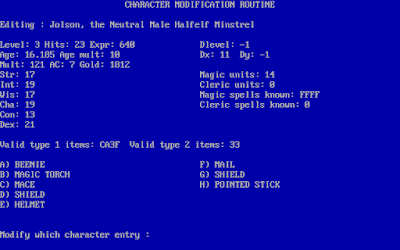 |
| The Nemesis Dungeon Master character editor. |
On a Google Group about a year ago, Pagels indicated that he and Hiller “had a great time writing this game, and it helped pay for grad school.” Neither continued in the gaming industry. I reached out to both for comments but didn’t get a response.
If we ever get hold of OrbQuest (1981), we may have a challenger, but until then, I’m willing to call Nemesis the best CRPG issued for the CP/M operating system. I’m glad we had a chance to check it out.
Original URL: http://crpgaddict.blogspot.com/2019/03/game-322-nemesis-1981.html

